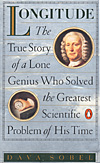 Penguin, 1995, $10.95, ISBN 0-14-025879-5, 184 pgs., paperback
Penguin, 1995, $10.95, ISBN 0-14-025879-5, 184 pgs., paperback
Back in the day of wooden ships and iron men, when exploration across the Atlantic Ocean was in full swing, captains figured their ships' positions based on dead reckoning. Latitude was easy to figure out based on sun, stars, or length of day. But longitude depended on time--ship time versus home port time, with the difference allowing a navigator to fix his position. As for the consequences of not knowing where a ship was at sea, shipwrecks aplenty serve as a reminder.
In 1714, the English Parliament offered a reward to anyone who could devise a system to determine longitude accurately. Many tried, especially with star charts, but only John Harrison succeeded in making a clock that could keep accurate time on bard a ship that rolled in the swells and sailed between the arctic and tropics.
This book tells the story of Harrison's invention, and the various power blocks which tried to claim credit. The story is more politics than mechanics, though it is a fascinating one of perseverance against the establishment.
It's short and a decent, if somewhat clinical, read. Credit Harrison with the invention, Thomas Earnshaw with its "mass production" refinements, and Sobel for unearthing the tale.
Back to List of Book Reviews: General Topics
Back to Master Book Review List
Back to Master Magazine List
© Copyright 2004 by Coalition Web, Inc.
This article appears in MagWeb.com (Magazine Web) on the Internet World Wide Web.
Other articles from military history and related magazines are available at http://www.magweb.com